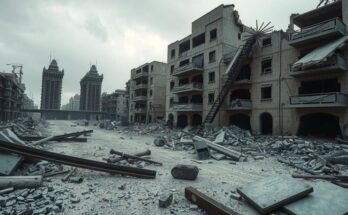The Sudanese army announced control over strategic sites in central Khartoum amid ongoing conflict with the RSF, including the Nile Towers and Sherwani Bus Station. The RSF maintains control in some areas while the humanitarian crisis worsens, with over 20,000 reported deaths and 14 million displaced. International appeals for an end to the violence are intensifying.
On Sunday, Sudan’s military announced its acquisition of strategic locations in central Khartoum from the paramilitary Rapid Support Forces (RSF). The military reported the seizure of the Nile Towers, a prominent high-rise building, and the Al Mansheiya Bridge, located in the capital’s center. Additionally, they secured the Sherwani Bus Station, which serves as the city’s main transportation hub.
Following these advances, the army has positioned itself closer to key sites, including the Army Command Center in western Khartoum and the Presidential Palace to the south. Despite these developments, the RSF had not provided any comment regarding the military’s assertions at the time of reporting.
In a recent video, RSF Commander Mohamed Hamdan Dagalo, often referred to as Hemedti, expressed that his forces would remain in both Khartoum and the Presidential Palace, which they have controlled since the conflict began. The RSF has seen its territorial control significantly diminish as the Sudanese army gains ground in multiple states, including Khartoum and surrounding areas.
The Sudanese army has achieved control over all of Bahri City and most of Omdurman City, with approximately 75% of central Khartoum now under its authority, including territories surrounding the Presidential Palace and the primary airport. However, the RSF retains control over the eastern and southern sections of the city.
Since mid-April 2023, the conflict between the Sudanese army and the RSF has resulted in over 20,000 fatalities and displaced around 14 million individuals, as reported by the UN and local sources. Furthermore, research from US universities estimates the death toll to be approximately 130,000. International and UN organizations are increasingly urging for a cessation of hostilities, as fears of a humanitarian disaster grow due to widespread famine and food shortages affecting millions across 13 of Sudan’s 18 states.
The ongoing situation in Sudan’s capital reflects a dire humanitarian crisis, exacerbated by the conflict’s escalation and the urgent need for international intervention. Immediate measures are necessary to address the increasing toll on human life and the severe impact on civilians caught in the violence.
In conclusion, the Sudanese army has made significant territorial gains in central Khartoum from the RSF, including key strategic locations such as the Nile Towers and the Sherwani Bus Station. Despite RSF’s ongoing control in parts of the city, the army’s advances indicate a shift in power dynamics. The humanitarian crisis in the region continues to escalate, with high death tolls and massive displacement of civilians prompting urgent calls for intervention from the international community.
Original Source: www.yenisafak.com




